Water Abundance Evaluation of Aquifer Using GA-SVR-BP: A Case Study in the Hongliulin Coal Mine, China
Abstract
:1. Introduction
2. Materials and Methods
2.1. Overview of the Research Area
2.2. Method
2.2.1. Principles of Support Vector Machines
2.2.2. BP Artificial Neural Network
- Input mode forward propagation
- 2.
- Output error backpropagation
2.2.3. GA-SVR-BP
2.3. Analysis of Factors Affecting Water Abundance
3. Results
4. Conclusions
Author Contributions
Funding
Data Availability Statement
Acknowledgments
Conflicts of Interest
References
- Rui, G.; Hao, Y.; Feng, J.; Mei, X.C.; Wang, X.L. Influential factors and control of water inrush in a coal seam as the main aquifer. Int. J. Min. Sci. Technol. 2018, 28, 187–193. [Google Scholar] [CrossRef]
- Wang, Q.Q.; Li, W.P.; Chen, W.; Bai, H.Y. GIS-based assessment of landslide susceptibility using certainty factor and index of entropy models for the Qianyang County of Baoji city, China. J. Ear. Syst. Sci. 2015, 124, 1399–1415. [Google Scholar] [CrossRef]
- Wang, Q.Q.; Li, W.P.; Li, T.; Li, X.Q.; Liu, S.L. Goaf water storage and utilization in arid regions of northwest China: A case study of Shennan coal mine district. J. Clean. Product. 2018, 202, 33–44. [Google Scholar] [CrossRef]
- Wu, Q.; Xu, K.; Zhang, W.; Wei, Z. Roof aquifer water abundance evaluation: A case study in Taigemiao, China. Arab. J. Geosci. 2017, 10, 254. [Google Scholar] [CrossRef]
- Wu, Q. Research progress, problems, and prospects of mine water prevention and control and resource utilization in China. J. Coal Ind. 2014, 39, 795–805. [Google Scholar]
- Sun, Y.J.; Chen, G.; Xu, Z.M.; Yvan, H.Q.; Zhang, Y.Z.; Zhou, L.J.; Wang, X.; Zhang, C.H.; Zheng, J.M. Research progress on the current situation of water environment in coal mining areas and the treatment and utilization of mine water in China. J. Coal Ind. 2020, 45, 304–316. [Google Scholar]
- Peng, S.P.; Bi, Y.L. Key technologies and strategic considerations for ecological environment restoration in coal mining areas of the Yellow River Basin. J. Coal Ind. 2020, 45, 1211–1221. [Google Scholar]
- Nampak, H.; Pradhan, B.; Manap, M.A. Application of GIS based data driven evidential belief function model to predict groundwater potential zonation. J. Hydrol. 2014, 513, 283–300. [Google Scholar] [CrossRef]
- Jia, P.Z. Study on evaluation method of water abundance for aquifer in coal deposits. Coal Sci. Technol. 2017, 45, 168–172. [Google Scholar]
- Jiang, Z.L.; Tian, Y.H. Integrated geophysical technology applied to watery evaluation of sinkhole. Coal Sci. Technol. 2015, 43, 139–142. [Google Scholar]
- Medici, G.; West, L.J. Reply to discussion on ‘Review of groundwater flow and contaminant transport modelling approaches for the Sherwood Sandstone aquifer, UK; insights from analogous successions worldwide’ by Medici and West. Quart. J. Eng. Geol. Hydrogeol. 2023, 56, qjegh2021-176. [Google Scholar] [CrossRef]
- Streetly, M.; Chakrabarty, C.; McLeod, R. 2000. Interpretation of pumping tests in the Sherwood Sandstone Group, Sellafield, Cumbria, UK. Quart. J. Eng. Geol. Hydrogeol. 2000, 33, 281–299. [Google Scholar] [CrossRef]
- Li, M.X. Exquisite exploration of Jurassic burnt rock water abundance of northern part of Tarim Basin. Coal Min. Technol. 2018, 23, 15–17. [Google Scholar]
- Xiao, L.L.; Wei, J.C.; Niu, C. Study on the distortion of apparent resistivity curves caused by the ‘infnite’ electrode space of a Pole-Pole array and its correction. J. Appl. Geophys. 2015, 118, 124–138. [Google Scholar] [CrossRef]
- Yang, B.B.; Sui, W.H.; Duan, L.H. Risk assessment of water inrush in an underground coal mine based on GIS and Fuzzy Set Theory. Mine Water Environ. 2017, 36, 617–627. [Google Scholar] [CrossRef]
- Yang, B.B.; Yuan, J.H.; Duan, L.H. Development of a system to assess vulnerability of flooding from water in karst aquifers induced by mining. Environ. Earth Sci. 2018, 77, 91. [Google Scholar] [CrossRef]
- Yin, H.Y.; Shi, Y.L.; Niu, H.G. A GIS-based model of potential groundwater yield zonation for a sandstone aquifer in the Juye Coalfeld, Shandong, China. J. Hydrol. 2018, 557, 434–447. [Google Scholar] [CrossRef]
- Zeng, Y.F.; Wu, Q.; Liu, S.Q. Evaluation of a coal seam roof water inrush: Case study in the Wangjialing coal mine. China Mine Water Environ. 2018, 37, 174–184. [Google Scholar] [CrossRef]
- Shen, J.J.; Wu, Q.; Liu, W.T. The development of the water-richness evaluation model for the unconsolidated aquifers based on the extension matter-element theory. Geotech. Geol. Eng. 2020, 38, 2639–2652. [Google Scholar] [CrossRef]
- Dhakate, R.; Chowdhary, D.K.; Rao, G. Geophysical and geomorphological approach for locating groundwater potential zones in Sukinda chromite mining area. Environ. Earth Sci. 2012, 66, 2311–2325. [Google Scholar] [CrossRef]
- Wang, P. Transient electromagnetic methond exploration of burnt rock groundwater in shallow. Coal Min. Technol. 2018, 23, 21–24. [Google Scholar]
- Shi, S.Q.; Wei, J.C.; Yin, H.Y.; Xie, D.L.; Yang, J.H. Prediction of water abundance of sandstone aquifer in coal seam roof of Jisan coal mine. Coalf. Geol. Explor. 2017, 45, 100–104. [Google Scholar]
- Cao, Q.K.; Zhao, F. Risk assessment of water inrush from coal seam floor based on fuzzy support vector machine. J. Coal Ind. 2011, 36, 633–637. [Google Scholar]
- Biswas, S.; Mukhopadhyay, B.P.; Bera, A. Delineating groundwater potentilal zones of agriculture dominated landscapes using GIS based AHP techniques: A case study from Uttar Dinajpur district. West Bengal Environ. Earth Sci. 2020, 79, 302. [Google Scholar] [CrossRef]
- Ma, L.J.; Zhao, B.F.; Wang, H.; Gao, Y. Analysis of spatial differences in permeability based on sedimentary and structural features of the sandstone aquifer overlying coal seams in western China. Mine Water Environ. 2020, 39, 229–241. [Google Scholar] [CrossRef]
- Wu, Q.; Fan, Z.L.; Liu, S.Q.; Zhang, Y.W.; Sun, W.J. A GIS-based method for evaluating the water abundance of information fusion type aquifers—The water abundance index method. J. Coal Sci. 2011, 36, 124–1128. [Google Scholar]
- Wu, X.R.; Wei, J.C.; Yin, H.Y.; Zhang, Y.Q. Prediction of water yield of roof sandstone based on Fuzzy clustering—Taking Longgu Mine Field as an example. J. Shandong Univ. Sci. Technol. (Nat. Sci. Ed.) 2011, 30, c14–c18. [Google Scholar]
- Cui, X.E.; Li, W.P. Multivariate information prediction and evaluation of water abundance of sandstone in fully mechanized mining roof. Coalf. Geol. Explor. 2015, 43, 43–47. [Google Scholar]
- Xue, J.K.; Shi, L.; Wang, H.; Ji, Z.K.; Shang, H.B.; Xu, F.; Zhao, C.H. Water abundance evaluation of a burnt rock aquifer using the AHP and entropy weight method: A case study in the Yongxin coal mine, China. Mine Water Environ. 2021, 80, 417. [Google Scholar] [CrossRef]
- Wang, Y.; Han, J.; Gao, W.F. Evaluation of the water richness of Austrian limestone based on principal component analysis. Chin. Sci. Technol. Pap. 2017, 12, 1011–1014. [Google Scholar]
- Fan, L.M.; Ma, L.Q.; Yu, Y.H. Water-conserving mining influencing factors identification and weight determination in northwest China. Int. J. Coal Sci. Technol. 2019, 6, 95–101. [Google Scholar] [CrossRef]
- Onifade, M.; Genc, B. Spontaneous combustion liability of coal and coal-shale: A review of prediction methods. Int. J. Coal Sci. Technol. 2019, 6, 151–168. [Google Scholar] [CrossRef]
- State Administration of Coal Mine Safety Supervision. Detailed Rules for Water Prevention and Control in Coal Mines; Coal Industry Press: Beijing, China, 2018.
- Chai, H.B.; Zhang, J.P.; Yan, C. Prediction of the height of water conducting fractured zone in mining overburden based on GA-SVR. J. Min. Saf. Eng. 2018, 35, 359–365. [Google Scholar]
- Sun, Y.P.; Wang, Y.F.; Zheng, X.J. Analysis of the height of coal seam roof water conducting Fractured zone based on genetic support vector machine method. J. Coal Ind. 2009, 34, 1610–1615. [Google Scholar]
- Lou, G.Z.; Tan, Y. Prediction of the height of water conducting fractured zone based on PSO-BP neural network. Coal. Geol. Explor. 2021, 49, 198–204. [Google Scholar]

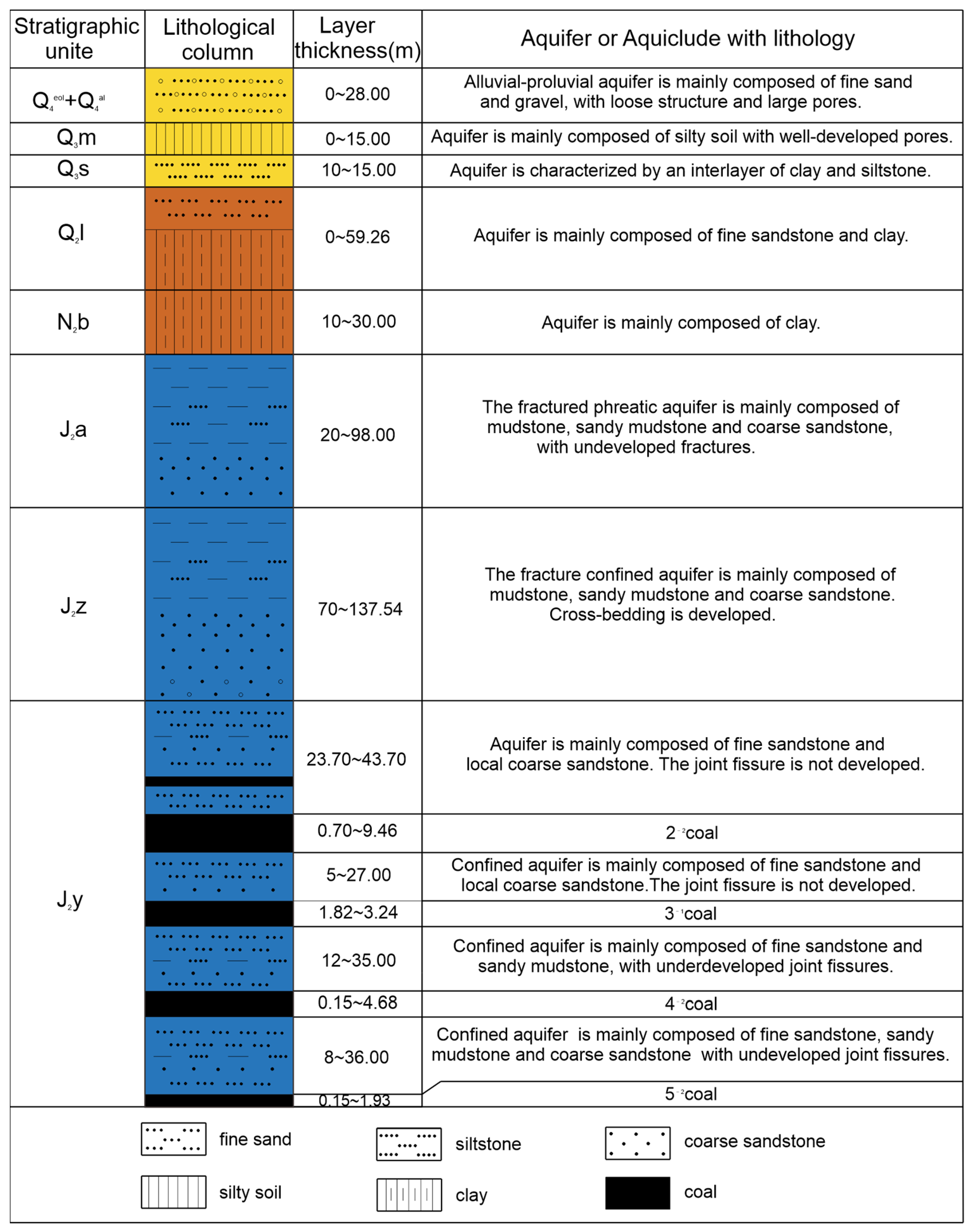
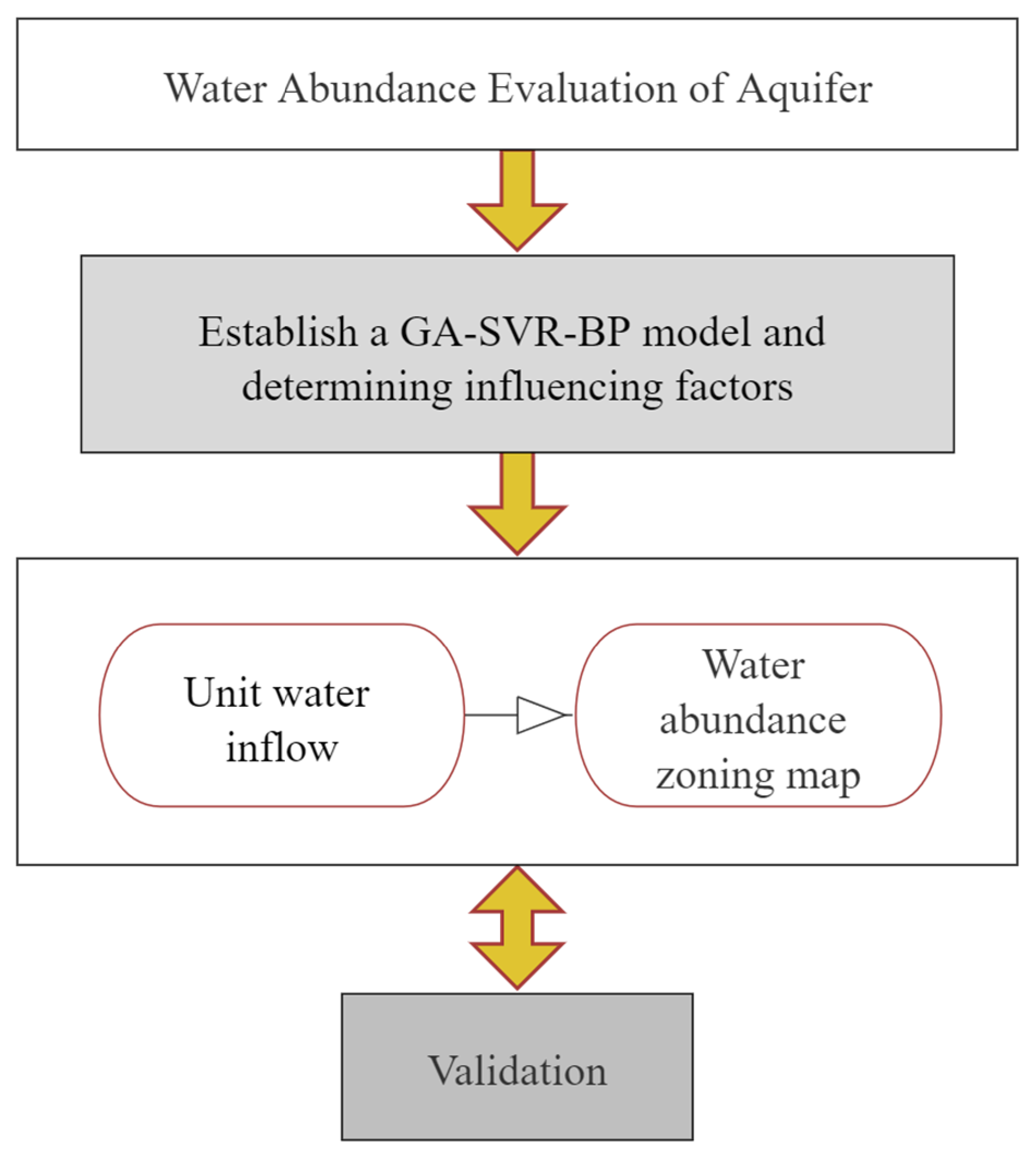
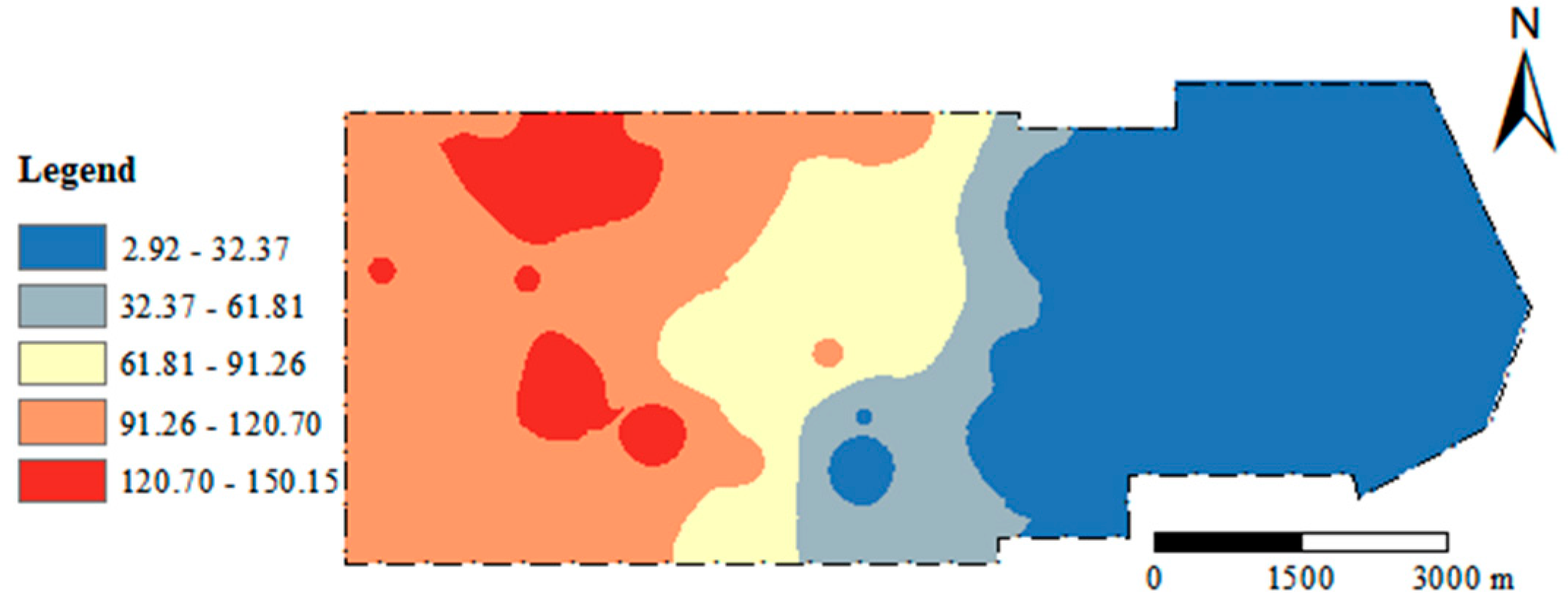
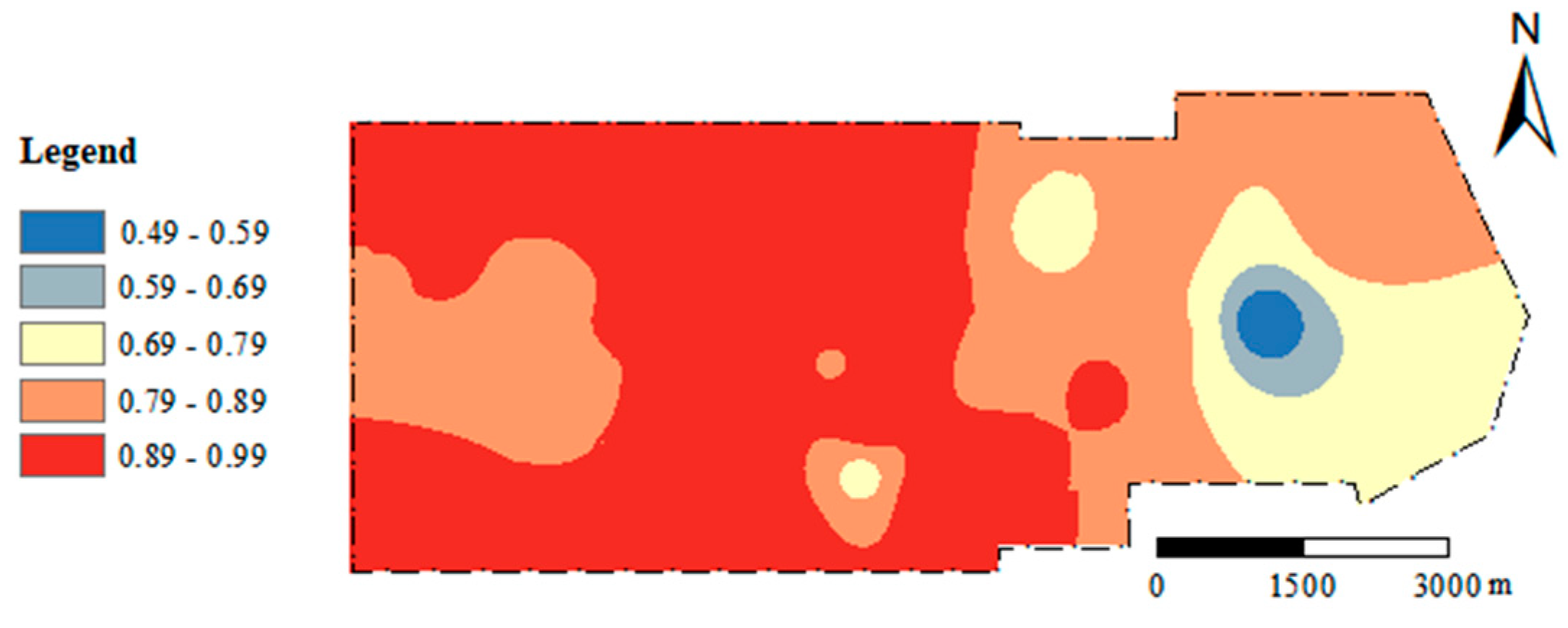
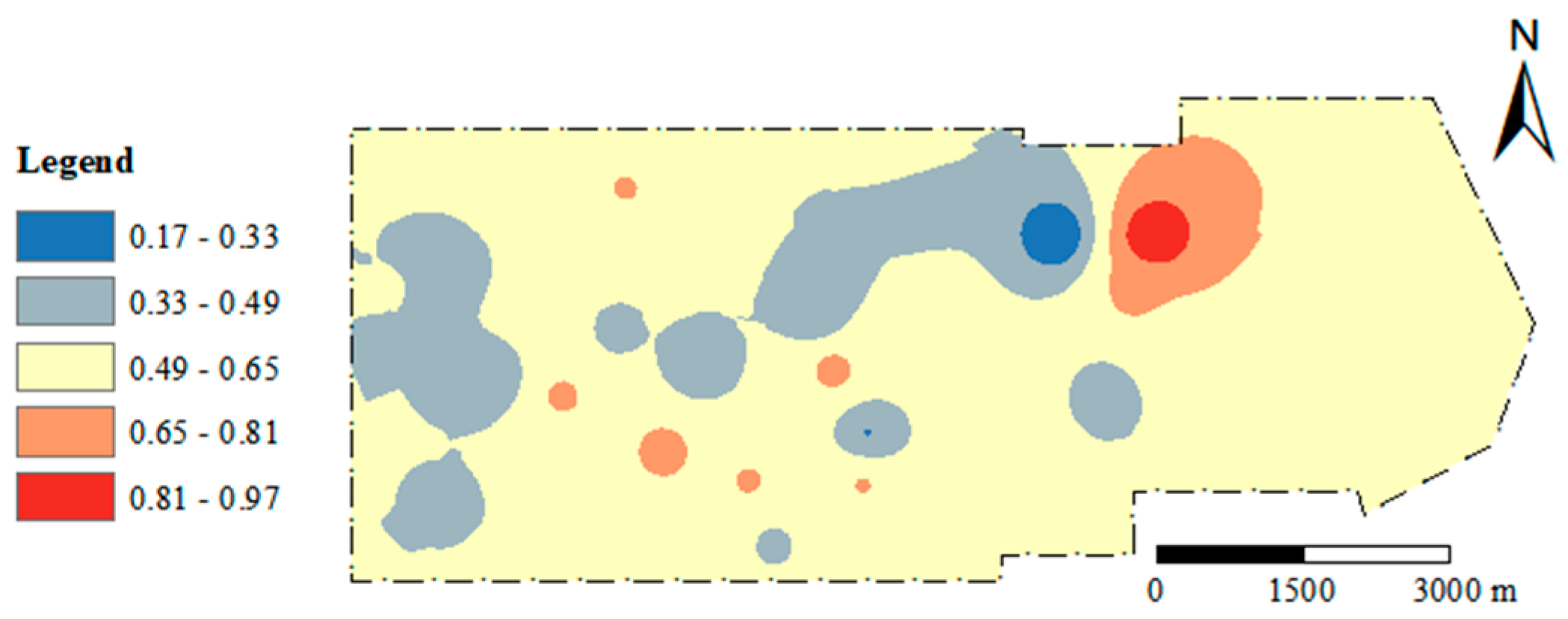
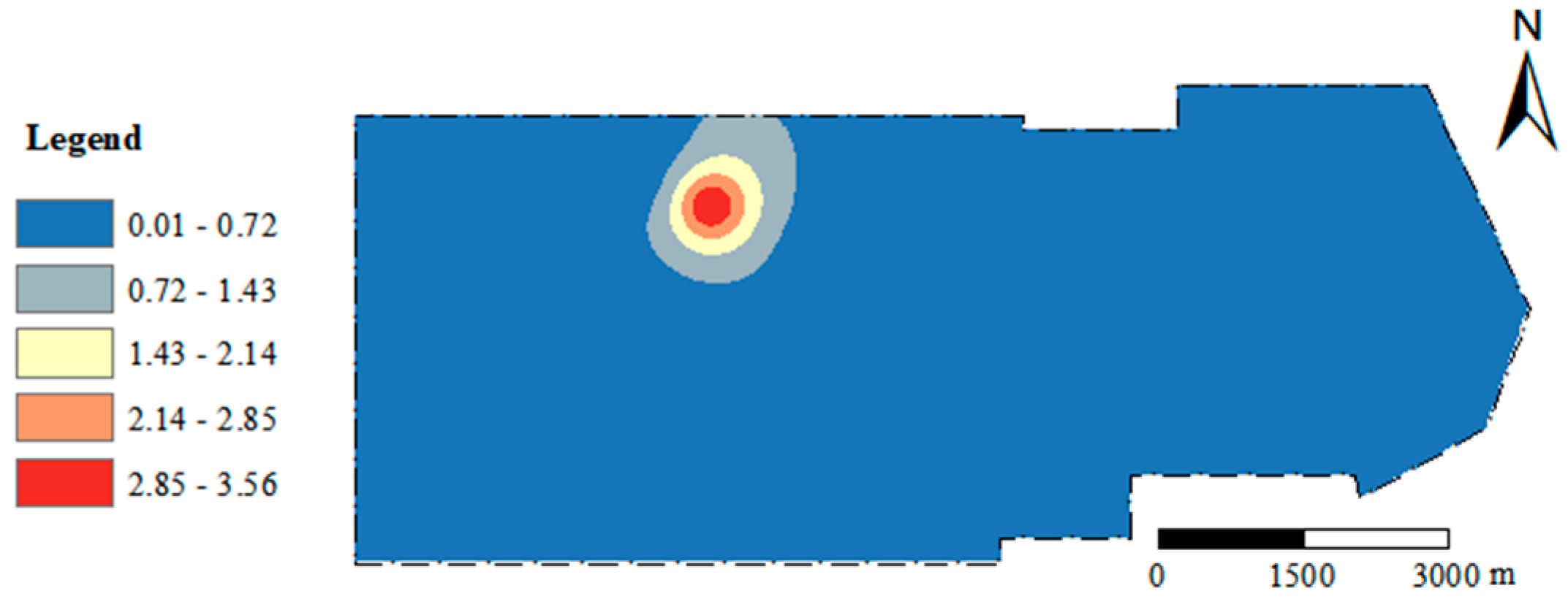
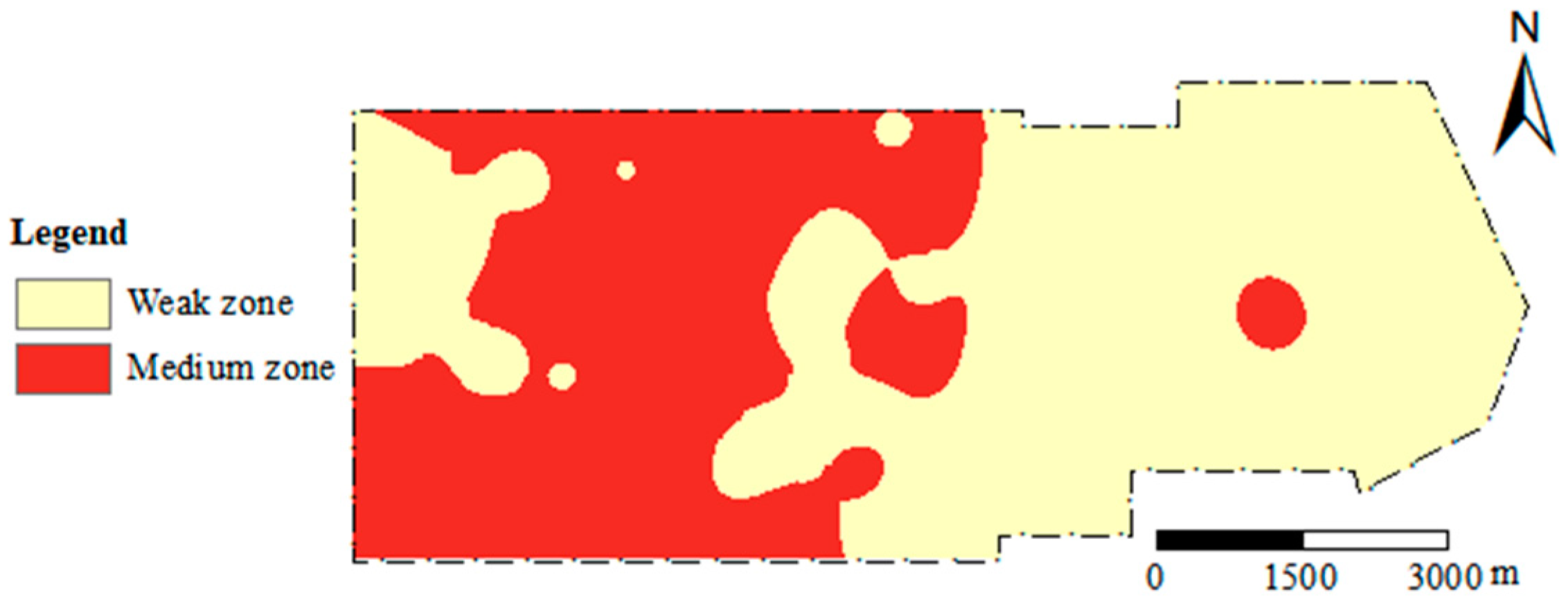
| No | Sandstone Thickness (m) | Core Recovery Ratio | Brittle Rock Thickness Ratio | Flushing Fluid Consumption (m3/h) | Unit Water Inflow q (L/m·s) | Predictive Value (L/m·s) | Predictive Classification (True or False) |
|---|---|---|---|---|---|---|---|
| 10-HB3 | 99.36 | 0.91 | 0.408 | 0.020 | 0.0522 | 0.0622 | weak (T) |
| 10-HB4 | 121.49 | 0.83 | 0.537 | 0.030 | 0.1829 | 0.1729 | medium (T) |
| 10-HB7 | 66.29 | 0.92 | 0.392 | 0.070 | 0.1220 | 0.1220 | medium (T) |
| 10-HB9 | 30.51 | 0.95 | 0.333 | 0.020 | 0.0150 | 0.0251 | weak (T) |
| 11-HB4 | 98.11 | 0.83 | 0.418 | 0.040 | 0.0593 | 0.0692 | weak (T) |
| 11-HB7 | 140.31 | 0.90 | 0.708 | 0.250 | 0.2150 | 0.2150 | medium (T) |
| 11-HB8 | 99.67 | 0.92 | 0.675 | 0.080 | 0.0240 | 0.0339 | weak (T) |
| 5-HB2 | 116.99 | 0.93 | 0.600 | 0.220 | 0.0799 | 0.0903 | weak (T) |
| 8-HB1 | 117.90 | 0.92 | 0.542 | 0.080 | 0.1108 | 0.1153 | medium (T) |
| 8-HB3 | 125.61 | 0.90 | 0.564 | 0.046 | 0.2482 | 0.2383 | medium (T) |
| 8-HB4 | 137.24 | 0.94 | 0.684 | 0.043 | 0.0788 | 0.0887 | weak (T) |
| 8-HB9 | 73.05 | 0.95 | 0.421 | 0.048 | 0.0072 | 0.0172 | weak (T) |
| 9-HB10 | 85.29 | 0.94 | 0.591 | 0.023 | 0.4371 | 0.4192 | medium (T) |
| 9-HB4 | 139.62 | 0.91 | 0.632 | 0.110 | 0.0481 | 0.0580 | weak (T) |
| 9-HB9 | 67.00 | 0.93 | 0.398 | 0.630 | 0.0030 | 0.0131 | weak (T) |
| HB1-12 | 99.08 | 0.88 | 0.726 | 0.040 | 0.0802 | 0.0907 | weak (T) |
| HB2-1 | 121.57 | 0.89 | 0.504 | 0.030 | 0.0202 | 0.0302 | weak (T) |
| HB2-14 | 42.35 | 0.98 | 0.541 | 0.230 | 0.0027 | 0.0123 | weak (T) |
| HB3-11 | 61.89 | 0.99 | 0.479 | 0.060 | 0.1549 | 0.1450 | medium (T) |
| HB3-6 | 150.16 | 0.85 | 0.690 | 0.040 | 0.0855 | 0.0960 | weak (T) |
| HB4-3 | 115.17 | 0.94 | 0.481 | 0.150 | 0.2165 | 0.2066 | medium (T) |
| 6-HB6 | 67.53 | 0.95 | 0.379 | 0.015 | 0.2308 | 0.2206 | medium (T) |
| 10-HB6 | 95.88 | 0.90 | 0.469 | 0.030 | 0.1617 | 0.1617 | medium (T) |
| 7-HB1 | 118.62 | 0.92 | 0.560 | 0.330 | 0.2126 | 0.2025 | medium (T) |
| 8-HB11 | 89.81 | 0.94 | 0.647 | 0.045 | 0.0415 | 0.0415 | weak (T) |
| 8-HB6 | 109.51 | 0.93 | 0.562 | 3.600 | 0.4733 | 0.4733 | medium (T) |
| HB4-6 | 101.78 | 0.92 | 0.569 | 0.100 | 0.3623 | 0.3623 | medium (T) |
| BK3-1 | 18.48 | 0.83 | 0.710 | 0.020 | 0.0085 | 0.0184 | weak (T) |
| BK4-2 | 21.81 | 0.86 | 0.649 | 0.010 | 0.0011 | 0.0109 | weak (T) |
| BK5 | 27.29 | 0.86 | 0.985 | 0.020 | 0.0134 | 0.0235 | weak (T) |
| BK7 | 6.15 | 0.73 | 0.672 | 0.010 | 0.1376 | 0.1272 | medium (T) |
| BK8 | 16.34 | 0.94 | 0.592 | 0.045 | 0.0079 | 0.0178 | weak (T) |
| BK9 | 16.16 | 0.93 | 0.414 | 0.040 | 0.0391 | 0.0391 | weak (T) |
| SK14 | 2.92 | 0.70 | 0.176 | 0.020 | 0.0114 | 0.0213 | weak (T) |
| SK21 | 27.40 | 0.79 | 0.598 | 0.030 | 0.0043 | 0.0143 | weak (T) |
| SK22 | 20.30 | 0.81 | 0.533 | 0.035 | 0.0327 | 0.0327 | weak (T) |
| SK23 | 9.08 | 0.50 | 0.621 | 0.056 | 0.1459 | 0.1369 | medium (T) |
| Water Abundance | Classification Standards | |||
|---|---|---|---|---|
| Weak Water Abundance | Medium Water Abundance | Strong Water Abundance | Extremely Strong Water Abundance | |
| unit water inflow q (L/(s∙m)) | q ≤ 0.1 | 0.1 < q ≤ 1.0 | 1.0 < q ≤ 5 | q > 5 |
Disclaimer/Publisher’s Note: The statements, opinions and data contained in all publications are solely those of the individual author(s) and contributor(s) and not of MDPI and/or the editor(s). MDPI and/or the editor(s) disclaim responsibility for any injury to people or property resulting from any ideas, methods, instructions or products referred to in the content. |
© 2023 by the authors. Licensee MDPI, Basel, Switzerland. This article is an open access article distributed under the terms and conditions of the Creative Commons Attribution (CC BY) license (https://creativecommons.org/licenses/by/4.0/).
Share and Cite
Wang, Q.; Han, Y.; Zhao, L.; Li, W. Water Abundance Evaluation of Aquifer Using GA-SVR-BP: A Case Study in the Hongliulin Coal Mine, China. Water 2023, 15, 3204. https://doi.org/10.3390/w15183204
Wang Q, Han Y, Zhao L, Li W. Water Abundance Evaluation of Aquifer Using GA-SVR-BP: A Case Study in the Hongliulin Coal Mine, China. Water. 2023; 15(18):3204. https://doi.org/10.3390/w15183204
Chicago/Turabian StyleWang, Qiqing, Yanbo Han, Liguo Zhao, and Wenping Li. 2023. "Water Abundance Evaluation of Aquifer Using GA-SVR-BP: A Case Study in the Hongliulin Coal Mine, China" Water 15, no. 18: 3204. https://doi.org/10.3390/w15183204
APA StyleWang, Q., Han, Y., Zhao, L., & Li, W. (2023). Water Abundance Evaluation of Aquifer Using GA-SVR-BP: A Case Study in the Hongliulin Coal Mine, China. Water, 15(18), 3204. https://doi.org/10.3390/w15183204






